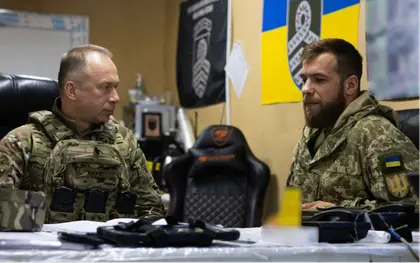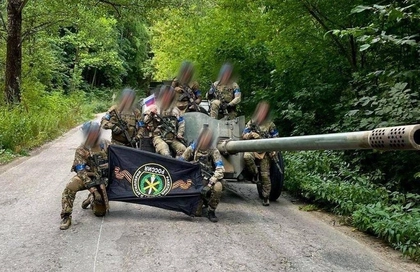The most senior officer of the Armed Forces of Ukraine (AFU), General Oleksander Syrsky, finished up two days of command visits to frontline unit headquarters in the threatened Adviivka sector on Monday, as President Volodymyr Zelensky said that the critical weapons needed to stop continuing Russian assaults – Western artillery ammunition – still hadn’t reached Kyiv’s troops in significant quantities.
Syrsky and his command group met with leadership of the veteran 47th and 59th Mechanized Infantry Brigades, and the more recently raised 115th Mechanized Infantry Brigade in a visit that took in half dozen major formations, news reports said.
JOIN US ON TELEGRAM
Follow our coverage of the war on the @Kyivpost_official.
The Kremlin’s current main ground effort in its more than two-year so-called special military operation is aimed at the cities of Pokrovsk and Kurahiv, in Ukraine’s Donetsk region according to comments made by Syrsky reported on official Ukrainian social media platforms on Monday.
Independent milbloggers and Ukrainian media have said the biggest Russian ground gains in the Pokrovsk-Avdiivka-Kurahiv sector followed a partial collapse of Ukrainian defenses held by the 115th Brigade around the villages Ocheretyne and Arkhangelske on April 22-23.
Russian ground forces led by the Kremlin’s 27th Motor Rifle Division have maintained momentum and are still gaining ground daily using tactics of small-scale infantry assaults aiming to capture a single defended wood-line or farm field, before attempting further advances - according to battle reports.

Ukraine Conducts Attack with Solely UGVs and FPV Drones, Destroying Russian Positions
Ukrainian milbloggers and official AFU statements have widely confirmed reports of heavy Russian losses in the attacks, particularly in men and light armored vehicles.
According to data compiled by independent researcher Ragnar Gudmundsson, the first week of May has seen Kremlin soldier losses near and possibly exceed wartime peak levels, with Russian army forces suffering 1,200 or more dead and wounded soldiers in three separate 24-hour days of the past seven.
According to open sources that level of Russian losses was probably only matched once, during the first days of Russia’s invasion of Ukraine. By some measures the current rate of Russian casualties at the beginning of May has exceeded those suffered by the Russian Imperial Army during World War One.
Russian troops according to mil-bloggers from both sides scored more local success near the villages Novoaleksandrivka and Novopokrovsk over the weekend, capturing nearly two square kilometers of farmland. Most attacks were by a few dozen or so Russian infantry riding on armored personnel carriers which they abandoned to attack on foot once they reached Ukrainian positions, battle reports said.
Syrsky said his discussions with local commanders focused on the coordination of men, weapons and material to inflict maximum casualties on the enemy while preserving Ukrainian soldier lives in the face of Kremlin’s “numerical advantage in personnel, weapons and military equipment.”
“Our task in these conditions is to hold the occupied lines and positions, use artillery fire, strike UAVs and all means to inflict maximum losses on the enemy, exhaust him, thereby disrupt the enemy's plans and gain time for the formation and preparation of our reserves,” Syrsky said.
Syrsky had previously warned that he would not tolerate inefficient officers and that a field commander unable to handle battle and lead his troops effectively could expect to be sacked.
There were no public reports of command changes in 115th Brigade following Syrsky’s visit despite the loss of ground around Ocheretyne. This was because, according to sources inside the unit speaking to Kyiv Post on background, the unit was ordered to hold too wide a sector and lacked sufficient troops to do so.
Syrsky in comments following his front-line tour called on all commanders to leave their headquarters and lead their roops from the front.
Describing his “work with unit commanders” during the frontline visits, Syrsky said his message to them was: “The role and place of the officer has always been decisive in achieving success or defeat on the battlefield. It is impossible for a company or battalion commander to manage a battle a few kilometers away from his units, and to make balanced and adequate decisions at a distance, especially when the intensity of hostilities escalates and there is a high risk to the lives of fighters.
“The presence of the commander plays a decisive role in maintaining a high level of morale and psychological state among subordinates, their stability, and confidence that they are not left to their own devices,” Syrsky said.

The general’s declaration – though absolutely in keeping with NATO best practices – contradicts increasingly common practice in the AFU where even junior leaders like captains and lieutenants command troops from a prepared position one or more kilometers behind the fighting line, using multiple screens with drone video feeds to observe the battlefield.
Junior officers have told Kyiv Post reporters that another advantage of fighting a battle using drone feeds, is that an officer has a good chance of living long enough to learn good tactics, which is less likely if he is always in front of his troops.
Syrsky took command of the AFU in February, replacing General Valery Zaluzhny. Syrsky ordered the army’s defensive strategy to be changed from holding ground at all costs to inflicting maximum possible casualties on Russian troops, even at the price of giving up defensive positions that had been held for years by Ukrainian troops.
President Volodymyr Zelensky in a May 5 evening national YouTube address told the audience that senior government officials met in the Stavka military command committee on Monday to discuss the difficult situation on the front particularly in the Avdiivka sector, and focused on Syrsky’s findings and recommendations.
“The first thing we discussed was the front. We received the report of the senior army commander (Syrsky). He was on the front line at the headquarters of forward brigades. He reported his key findings and on critical needs. We are taking steps to get ready,” Zelensky said.
The Stavka would accelerate deliveries of ammunition and weapons to front-line brigades “to the maximum” but underlined that western deliveries of critically-short artillery ammunition have not yet reached Ukraine, the Ukrainian leader said.
You can also highlight the text and press Ctrl + Enter






